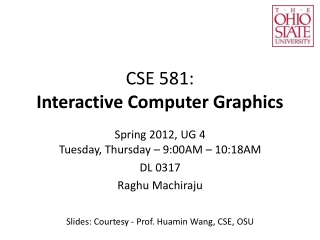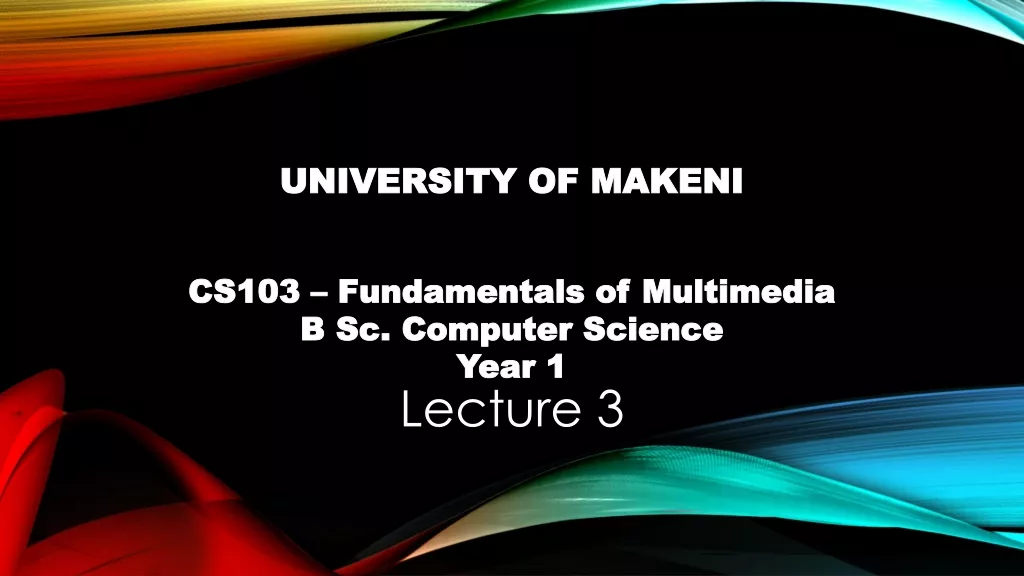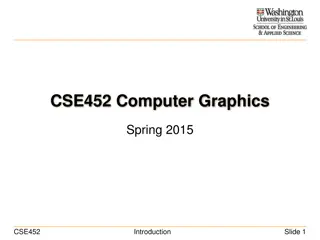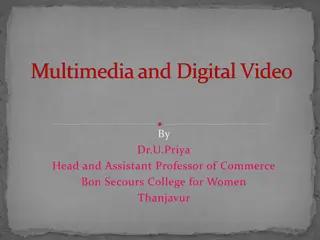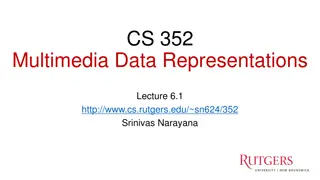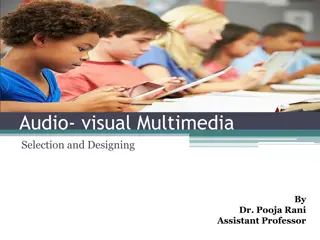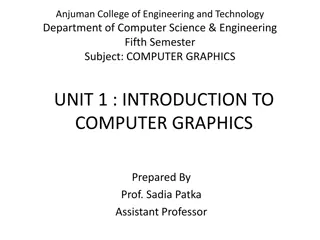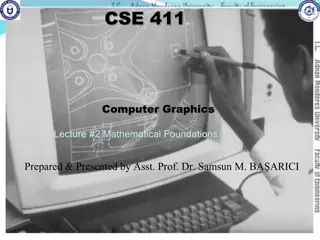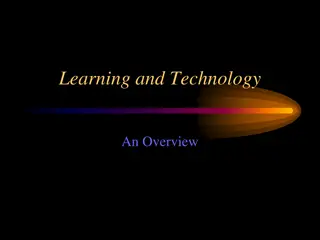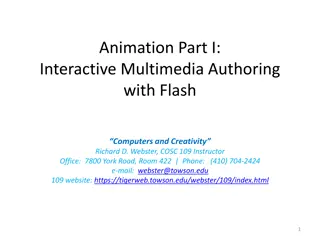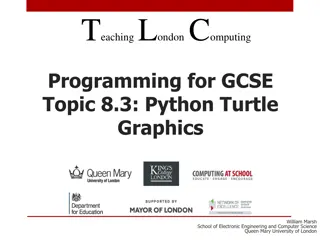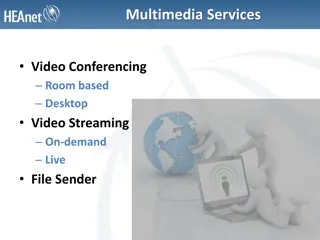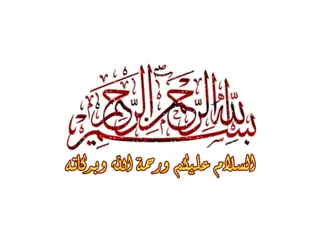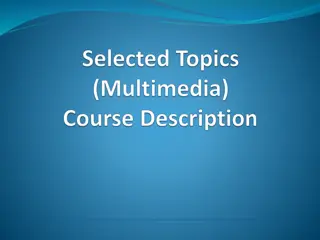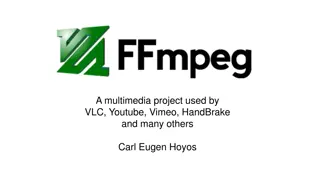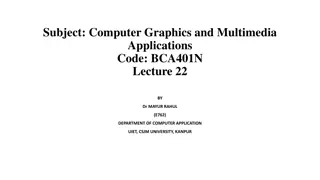Computer Graphics and Multimedia Applications Overview
This content provides an overview of computer graphics and multimedia applications covering topics such as primitive instancing, sweep representations, boundary representations, and spatial partitioning. It discusses the concepts and methods used in creating three-dimensional objects from two-dimensional shapes, including translational and rotational sweeps. The information delves into the challenges and benefits of different representation techniques in computer graphics.
Download Presentation

Please find below an Image/Link to download the presentation.
The content on the website is provided AS IS for your information and personal use only. It may not be sold, licensed, or shared on other websites without obtaining consent from the author.If you encounter any issues during the download, it is possible that the publisher has removed the file from their server.
You are allowed to download the files provided on this website for personal or commercial use, subject to the condition that they are used lawfully. All files are the property of their respective owners.
The content on the website is provided AS IS for your information and personal use only. It may not be sold, licensed, or shared on other websites without obtaining consent from the author.
E N D
Presentation Transcript
Subject: Computer Graphics and Multimedia Applications Code: BCA401N BY Dr MAYUR RAHUL (E762) DEPARTMENT OF COMPUTER APPLICATION UIET, CSJM UNIVERSITY, KANPUR
OUTLINE Primitive Instancing Sweep Representation Boundary Representations Spatial Partitioning Representations Constructive Solid Geometry Comparison of Representations
Primitive Instancing This scheme is based on notion of families of object, each member of a family distinguishable from the other by a few parameters. Each object family is called a generic primitive, and individual objects within a family are called primitive instances. For example, a family of bolts is a generic primitive, and a single bolt specified by a particular set of parameters is a primitive instance. The distinguishing characteristic of pure parameterized instancing schemes is the lack of means for combining instances to create new structures which represent new and more complex objects. The other main drawback of this scheme is the difficulty of writing algorithms for computing properties of represented solids. A considerable amount of family-specific information must be built into the algorithms and therefore each generic primitive must be treated as a special case, allowing no uniform overall treatment.
Sweep Representation Sweep representations are used to construct three dimensional objects from two dimensional shape . There are two ways to achieve sweep: Translational sweep and Rotational sweep. In translational sweeps, the 2D shape is swept along a linear path normal to the plane of the area to construct three dimensional object. To obtain the wireframe representation we have to replicate the 2D shape and draw a set of connecting lines in the direction of shape, as shown in the figure (8)
Sweep Representation In rotational sweeps, the 2D shape is rotated about an a axis of rotation specified in the plane of 2D shape to produce three dimensional object. This is illustrated in figure (9). In general we can specify sweep constructions using any path. For translation we can vary the shape or size of the original 2D shape along the sweep path. For rotational sweeps, we can move along a circular path through any angular distance from 0 to 360 . These sweeps whose generating area or volume changes in size, shape or orientation as they are swept and that follow an arbitrary curved trajectory are called general sweeps . General sweeps are difficult to model efficiently for example, the trajectory and object shape may make the swept object intersect itself, making volume calculations complicated. Further more, general sweeps do not always generate solids. For example, sweeping a 2D shape in its own plane generates another 2D shape.
Boundary Representations Boundary Representation, or B-rep for short, can be considered as an extension to the wireframe model. The merit of a B-rep is that a solid is bounded by its surface and has its interior and exterior. The surface of a solid consists of a set of well-organized faces, each of which is a piece of some surface (.e.g., a surface patch). Faces may share vertices and edges that are curve segments. Therefore, a B-rep is an extension to the wireframe model by adding face information to the latter. There are two types of information in a B-rep: topological and geometric. Topological information provides the relationships among vertices, edges and faces similar to that used in a wireframe model. In addition to connectivity, topological information also includes orientation of edges and faces. Geometric information is usually equations of the edges and faces.
Boundary Representations The orientation of each face is important. Normally, a face is surrounded by a set of vertices. Using the right-handed rule, the ordering of these vertices for describing a particular face must guarantee that the normal vector of that face is pointing to the exterior of the solid. Normally, the order is counter clockwise. If that face is given by an equation, the equation must be rewritten so that the normal vector at every point on the part that is being used as a face points to the exterior of the solid. Therefore, by inspecting normal vectors one can immediately tell the inside and outside of a solid under B-rep. This orientation must be done for all faces. The following shows three faces and their outward pointing normal vectors. To describe the top surface, the vertices should be 6, 7, 2, 1 or 7, 2, 1, 6 or 2, 1, 6, 7 or 1, 6, 7, 2. To describe the left face, the order should be 1, 2, 3, 4 or 2, 3, 4, 1 or 3, 4, 1, 2 or 4, 1, 2, 3.
Spatial Partitioning Representations In geometry, space partitioning is the process of dividing a space (usually a Euclidean space) into two or more disjoint subsets. In other words, space partitioning divides a space into non-overlapping regions. Any point in the space can then be identified to lie in exactly one of the regions. In computer science, binary space partitioning (BSP) is a method for recursively subdividing a space into two convex sets by using hyperplanes as partitions. This process of subdividing gives rise to a representation of objects within the space in the form of a tree data structure known as a BSP tree.
Constructive Solid Geometry Constructive solid geometry (CSG; formerly called computational binary solid geometry) is a technique used in solid modeling. Constructive solid geometry allows a modeler to create a complex surface or object by using Boolean operators to combine simpler objects, potentially generating visually complex objects by combining a few primitive ones. In 3D computer graphics and CAD, CSG is often used in procedural modeling. CSG can also be performed on polygonal meshes, and may or may not be procedural and/or parametric. Contrast CSG with polygon mesh modeling and box modeling.
REFERENCES https://www.tutorialspoint.com/ https://www.studytonight.com/ https://www.geeksforgeeks.org/ https://www.javatpoint.com/


